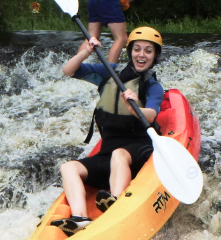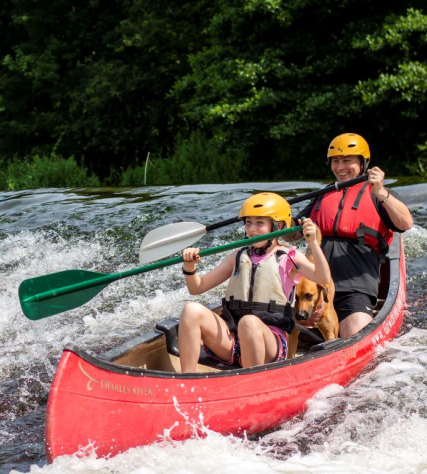

Tips For Safer Canoeing and Kayaking
Go with the Flow – River Adventures is a family run, adventure activity business established in 1996 by Charlie Horan. We offer affordable, guided canoe trails, canoe hire and canoe holidays on the beautiful Barrow river. No experience required – our adventures are available to complete beginners of all ages and abilities. We also sell canoes and kayaks.
-
Wear a Buoyancy Jacket
By law you are required to wear at least a buoyancy jacket on the water, we will not tolerate anyone not wearing one. Capsizing in a canoe or kayak is ALWAYS a possibility, a buoyancy jacket will keep you afloat. Buoyancy jackets are essential, not only for flotation, but for hypothermia protection. And by the way, after most drownings from canoes or kayaks, buoyancy jackets are seen floating nearby…empty. You have to WEAR them! We will provide one for everyone.
-
Clothing
Dressing properly for existing and expected conditions is critical. Extreme cold requires wet or dry suits, but in more moderate conditions layered clothing is recommended. Fabric choices should include those that provide warmth, even when wet. Cotton should never be worn in cold weather conditions. Man made fabrics like polyester is a good option as it is more likely to dry faster. Proper protection from the sun should also be considered. Considera fleece, jerseys or other sportswear when packing.
-
Footwear
Don’t forget shoes. Old runners are best and should be worn at all times. Bare feet have no place in canoeing, the terrain of the land and the bottom of the river can be hazardous. The river bed and bank could have sharp rocks, broken glass and fish hooks. Flip flops and crocs will not suffice.
-
If you Capsize
If your boat capsizes, don’t panic. Your canoe or sit-on-top kayak can be flipped back over. If you are on a guided tour, lucky you, your guide will get you back into your boat even in the middle of the river. Also remember overturned canoes float. First, assure that all passengers are safe before attempting to retrieve equipment. If possible get the rope that's attached to the boat and swim to the river bank. Once there only then slowly attempt to pull in the boat. If this is not possible due to obstruction, stay with your canoe unless you judge that doing so will be dangerous. If you can stay with the canoe you can guide it into quiet water. Stay at the upstream end of the canoe so that if the canoe becomes pinned, you don’t. If possible hold on to your paddle…you’ll need it later. Don’t try to swim in rapids. Float in your buoyancy jacket on your back, with your feet downstream. If someone else’s canoe has capsized, offer your assistance. If it comes down to a rescue, remember it’s the people first, then the equipment. If it’s cold, get them onto the river bank, dry them and warm them immediately. The most likely time of capsize is getting in and out of the boat, in faster moving water and if you paddle into a tree, branch or bush.
-
Know the Weather
Alway regularly check the weather when partaking in an outdoor activity. Wind speed and direction can cause a lot more issues when paddling that rain sometimes can.
-
Be Honest
It’s important to know the limitations of your abilities. Be honest with yourself and your companions. Your life and the lives of those in your party may depend on how everyone understands each other’s capabilities. If you overstate your abilities, eventually someone is going to be counting on help that you won’t be able to give them, so if you’re a novice, admit it. If you’re a pro, admit that, too. The novices in the group will feel better knowing you’re along on the trip.
-
Know the Water
Don’t attempt rivers or rapids beyond your ability. Progress gradually from one skill level to the next. Unfamiliar waters are no place to test your limits, or try to impress anybody. Each stream or river presents unique challenges, and dangers. Even well-seasoned veterans need to become familiar with the body of water before embarking on a journey.
-
Go in a Group
Boating alone is not recommended. The rule is ‘Less Than Three Should Never Be’ if one person gets hurt another person can stay with them while the third person gets help. Even though recreational canoeists often canoe with a single canoe and one partner, or even solo, it is recommended you canoe with at least three people or two craft. The less the skill of the paddler, and the less that is known about the river, the more important this rule becomes.
-
Carry Proper Equipment
Depending on the Adventure you are booking, pack your kit accordingly. Proper clothing is essential, always avoid cotton and ensure you will be warm and as dry as is necessary for the duration of your trip. Carry a spare paddle in the boat. An extra safety throwing line (at least 50 feet in length) can be very valuable. But be careful how you stow these lines. If the canoe spills, feet can become entangled in loose lines, and this can lead to serious trouble. There should be nothing around which will attach someone to a swamped canoe. Loose lines can be deadly. You’ll also want to pack a First Aid Kit and secure it to the boat. Paddle sports enthusiasts often operate in remote areas where medical attention is not readily available. And it wouldn’t hurt to take a first aid and CPR course while you’re at it. Store small items such as sunscreen and bug repellent, food and snacks in a waterproof dry-bag, tethered to the boat. When tying down these items, make sure they are stowed in an area that will not interfere with the users’ ability to exit the vessel safely in the event of a capsize. A bailer or bucket can be handy to remove water from inside the boat if it rains. A knife can be useful on the river incase ropes need to be cut.
-
Loading your Boat
Distribute the weight evenly. Look for ways to save space and to leave excess weight behind and don't overload the boat. Along the River Barrow for longer trips you may be passing through towns and villages which will allow for restocking of supplies. Make sure your boat’s load is balanced, side to side and front to back.
-
Stay out of Cold Water
Cold water causes death in nearly half of the drowning cases reported. Ensure your clothing is appropriate. Dry suits can be worn in colder months. Ensure you have suitable spare clothing that you can keep dry.
-
Inform Someone On Land
If you’re on a canoe or kayaking trip, somebody on land needs to know in case you get into trouble. The only way that can happen is if you tell a family member or friend in advance of your trip. Let them know where you're going, what you're doing and a timeframe of when you will contact them again. Give them the names of all the group members, the place you’ll be starting and ending your trip, when you plan to arrive at your destination and any waypoints in between. Give them instructions on when and who to contact if you are not in contact with them as planned.
-
Don’t Crowd your Buddy
Keep some distance between you and other paddlers. Especially on rapids and restricted passages such as in locks, keep a safe distance behind other boats. Don’t crowd, and back paddle if necessary. You don't want to be so close to someone that they could hit you with a paddle especially in the face. If someone encounters trouble, be willing to stop and offer your assistance. At put-in and take-out points, be courteous and take turns.
-
Glasses and sunglasses
You’ll need a strap for attaching them to your head. This is particularly important during a capsize when eyewear can easily slip off and sink. A shoe lace at minimum can help secure your glasses, or leave them behind if you can.
-
Remember
- Standing up or moving about in a canoe greatly increase the chance of
- Capsize.
- Wear a Buoyancy Jacket.
- Load the boat properly.
- Don't bring anything you don't want to lose or get wet.
- Don’t drink alcohol or take drugs immediately preceding or during a paddling trip.
- Understand your limitation and that of the vessel.
- Plan ahead.
- Know how to swim.
- Never paddle alone.
- If you need help or advice ask for it. Pick up the phone and call us.



